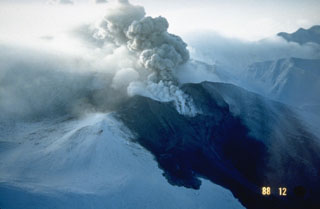Report on Tokachidake (Japan) — May 1987
Scientific Event Alert Network Bulletin, vol. 12, no. 5 (May 1987)
Managing Editor: Lindsay McClelland.
Tokachidake (Japan) Ground temperature increase; tremor and seismic swarms
Please cite this report as:
Global Volcanism Program, 1987. Report on Tokachidake (Japan) (McClelland, L., ed.). Scientific Event Alert Network Bulletin, 12:5. Smithsonian Institution. https://doi.org/10.5479/si.GVP.SEAN198705-285050
Tokachidake
Japan
43.418°N, 142.686°E; summit elev. 2077 m
All times are local (unless otherwise noted)
Thermal activity remained at a relatively high level around the June 1985 crater, which formed on the E wall of the 1962 summit crater during an eruption of hot muddy water [from two fissure vents]. Underground temperatures around the crater have increased since 1984, to 529°C during a field survey on 7 October 1986. Continuous tremor was recorded on 20 December 1986 from 0020 to 0046 at a seismograph station 4.5 km NNW of the 1962 craters. Volcanic tremor had last been recorded on 1 September 1985. Tremor resumed at 0716 on 11 February and lasted for 32 minutes. Smaller amplitude tremor (~10% of former events) occurred on 21 February and twice on 1 March, lasting 12, 13, and 43 minutes respectively. Swarms of volcanic microearthquakes were recorded on 25 November and 6 December 1986. 82 events were registered on 25 November and 32 events on 6 December by the seismograph 2 km NW of the 1962 crater.
Geological Summary. Tokachidake volcano consists of a group of dominantly andesitic stratovolcanoes and lava domes arranged on a NE-SW line above a plateau of welded Pleistocene tuffs in central Hokkaido. Numerous explosion craters and cinder cones are located on the upper flanks of the small stratovolcanoes, with the youngest Holocene centers located at the NW end of the chain. Frequent historical eruptions, consisting mostly of mild-to-moderate phreatic explosions, have been recorded since the mid-19th century. Two larger eruptions occurred in 1926 and 1962. Partial cone collapse of the western flank during the 1926 eruption produced a disastrous debris avalanche and mudflow.
Information Contacts: JMA.

